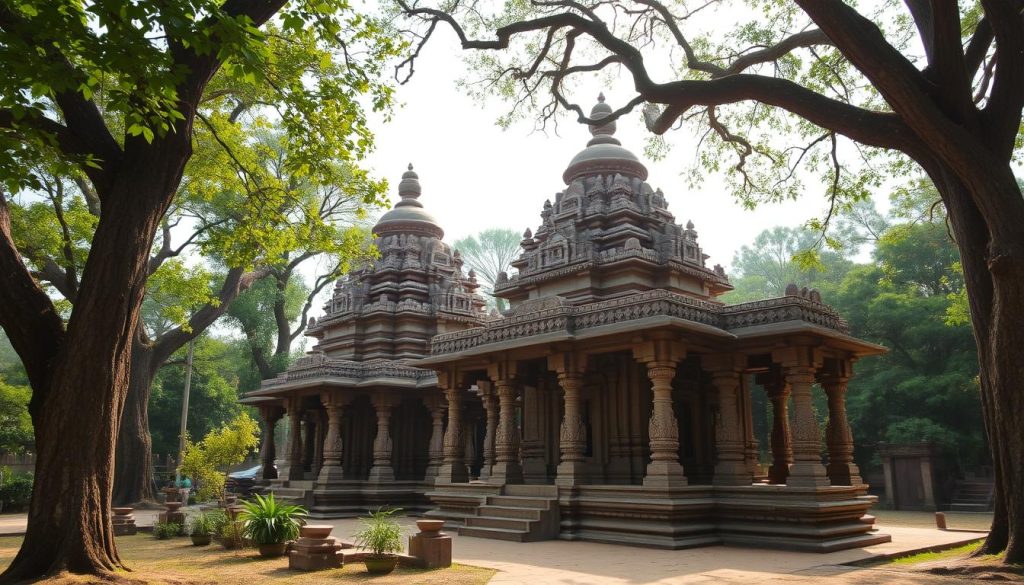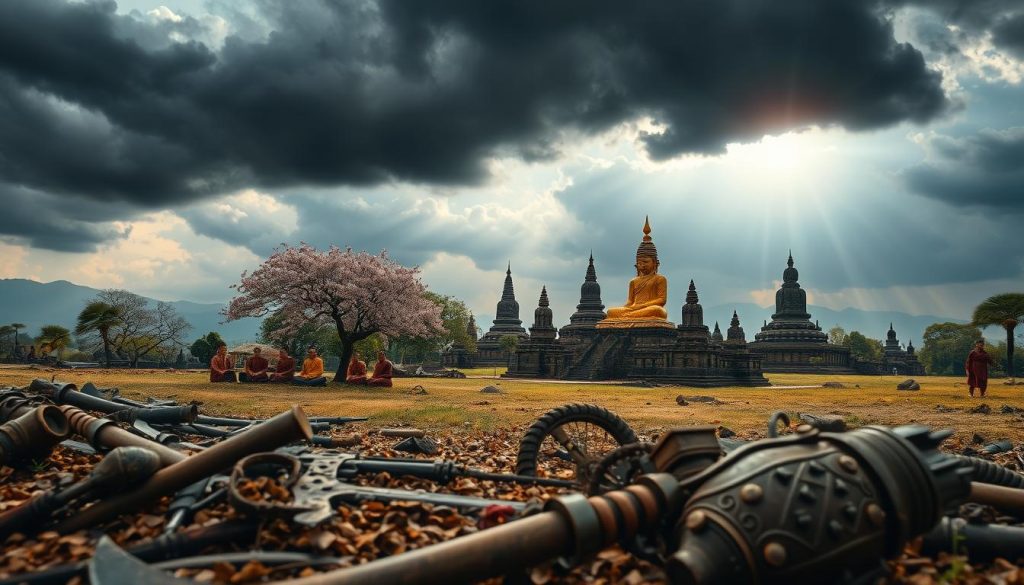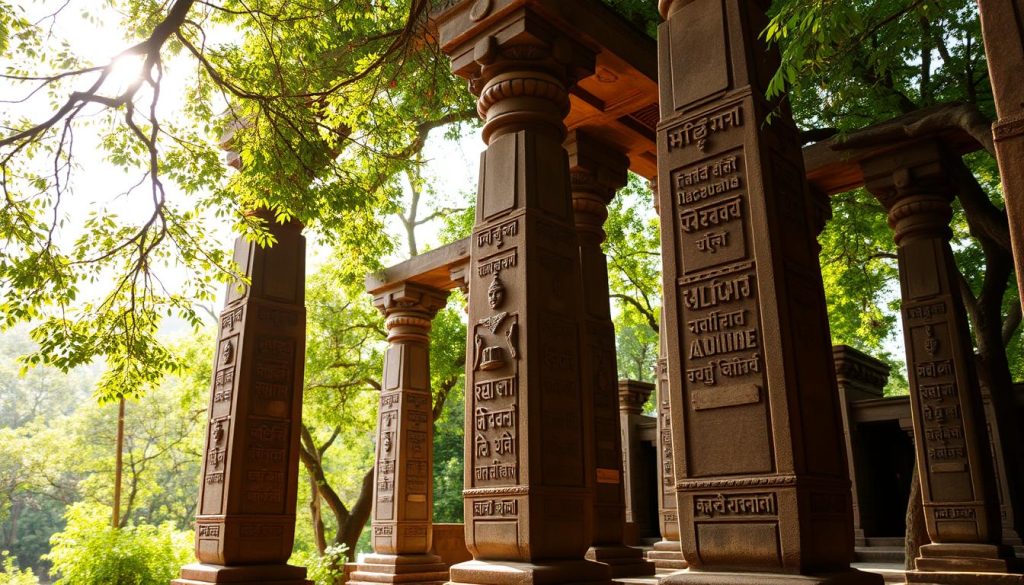Explore Ancient Temples & Culture of Odisha
Odisha is a hidden treasure in India’s rich cultural scene. It has a long history filled with ancient temples and a deep cultural heritage. Places like the Konark Sun Temple and the Puri Jagannath Temple show the state’s architectural wonders and traditions.

Learn about the Kalinga Empire’s impact on Odisha’s culture. See how the state’s diverse landscapes and customs shape its tribal communities. Discover the beauty of Odissi dance and the traditional crafts and textiles that have been passed down for generations.
Key Takeaways
- Odisha is a treasure trove of ancient temples and rich cultural heritage.
- The state’s history is shaped by the Kalinga Empire, whose cultural influence extended far and wide.
- Odisha boasts a diverse landscape and vibrant customs of its indigenous tribal communities.
- The state is renowned for its intricate Odissi dance and traditional handicrafts and textiles.
- Explore the architectural marvels of the Konark Sun Temple and the sacred Puri Jagannath Temple.
Introduction to Odisha’s Rich Cultural Heritage
Odisha is a state in eastern India known for its vibrant culture. It was shaped by the ancient Kalinga Empire. This area is full of diverse traditions, art, and sacred rituals that have lasted through time.
Historical Significance of the Kalinga Empire
The Kalinga Empire thrived in the 3rd century BCE. It was a key factor in forming Odisha’s cultural identity. The empire was known for its military strength and architectural achievements.
Many grand temples were built during this time. These temples show the empire’s skill in architecture and their deep faith.
Overview of Cultural Diversity
Odisha’s culture is rich and varied. It includes the traditions of tribal communities and the influences of Hindu, Buddhist, and Jain beliefs. The state is famous for its Odissi dance, Sambalpuri textiles, and metalwork.
Geographic and Cultural Landscapes
Odisha’s geography is diverse, with coastlines, valleys, forests, hills, and lakes. These landscapes have inspired local art and traditions. They have also shaped the state’s customs, festivals, and religious practices.

“Odisha’s cultural heritage is a tapestry of diverse traditions, woven together by the threads of history, geography, and the unwavering resilience of its people.”
The Magnificent Konark Sun Temple: A UNESCO World Heritage Site
The Konark Sun Temple is a gem on the Bay of Bengal’s shores. It showcases Odisha’s architectural and cultural splendor. Built in the 13th century, it’s a UNESCO World Heritage Site. It draws visitors worldwide with its detailed carvings and deep meaning.
The Konark Sun Temple is a marvel of Kalinga architecture. It looks like a chariot, symbolizing the sun’s path. Its height of nearly 230 feet and detailed walls are awe-inspiring. They show a variety of deities, mythological beings, and everyday life scenes.
The temple’s carved stone wheels are a highlight. Each is nearly 8 feet in diameter. These wheels, along with the temple’s many carvings, tell the story of Kalinga’s rich culture. They show the talent and creativity of Kalinga sculptors.
The Konark Sun Temple is more than just a building. It holds deep spiritual value. Its design is full of symbols, representing life’s cycle, time’s passage, and the cosmos’s dance.
“The Konark Sun Temple is a true masterpiece of Odishan architecture, a testament to the region’s unparalleled artistic and cultural legacy.”
Today, the Konark Sun Temple is a symbol of Odisha’s cultural strength. Being a UNESCO World Heritage Site highlights its global importance. It shows the need to protect this architectural wonder for future generations.

Puri Jagannath Temple: The Sacred Abode of Lord Jagannath
In the heart of Odisha, the Puri Jagannath Temple stands tall. It’s a place of deep spiritual meaning for many. The temple shows the rich culture of the area.
Religious Significance and Traditions
The Puri Jagannath Temple is a key spot for Hindu pilgrims. It’s one of the “Char Dham” sites in India. People come to find blessings from Lord Jagannath, a form of Lord Krishna.
The temple’s rituals and traditions have been kept alive for many years. They offer a deep spiritual experience to all who visit.
Annual Rath Yatra Festival
The Rath Yatra festival is famous at the Puri Jagannath Temple. It’s a big event where the deities of Lord Jagannath and his family are carried in a grand procession. Millions watch this amazing event, showing the area’s lively culture.
Temple Architecture and Design
The Puri Jagannath Temple is a stunning example of Kalinga architecture. Its 214-foot-tall spire, the Nilachakra, is impressive. The temple’s carvings and decorations show the area’s cultural wealth and love for Lord Jagannath.
“The Puri Jagannath Temple is a sacred sanctuary that transcends the boundaries of time and culture, embodying the essence of Odisha’s spiritual legacy.”
Ancient Temples of Bhubaneswar: The Temple City
Bhubaneswar, the capital of Odisha, is called the “Temple City.” It’s because of the many ancient temples here. These temples show off Odisha’s rich culture. They are hidden in the city, giving us a peek into the past.
The temples in Bhubaneswar are known for their different styles. The Lingaraj Temple has a unique Kalinga-style spire. The Mukteshvara Temple is famous for its detailed carvings.
- The Lingaraj Temple, dedicated to Lord Shiva, is one of the largest and most revered temples in Bhubaneswar, dating back to the 11th century.
- The Mukteswara Temple, renowned for its exquisite sculpted motifs, is considered a masterpiece of Odishan temple architecture.
- The Rajarani Temple, with its distinctive red sandstone exterior, showcases the region’s unique architectural style and is a popular tourist attraction.
These temples are more than just places of worship. They show how Odisha’s culture and history have changed over time. Visitors to Bhubaneswar can feel the city’s spiritual vibe. They can also admire the amazing craftsmanship and grand design of these ancient temples.
“Bhubaneswar, the ‘Temple City’ of Odisha, stands as a testament to the region’s rich cultural heritage, showcasing a remarkable concentration of ancient temples that captivate visitors with their architectural splendor and historical significance.”
Evolution of Kalinga Architecture Through Ages
Odisha’s Kalinga region boasts a rich architectural heritage. It has evolved over centuries, showing the region’s cultural and historical importance. The Kalinga architectural style is known for its unique features, innovative designs, and detailed craftsmanship. These have drawn visitors from all over the world.
Distinctive Features and Styles
Kalinga architecture is famous for its ornate and intricate carvings. These often show detailed motifs and mythological scenes. The temples are built with sandstone or granite, using the region’s natural resources.
The unique tower-like structures, known as shikhara, are a key feature. They rise high above the temple complexes.
Architectural Innovations
Kalinga architecture is known for its innovative structural techniques. The Rekha Deul and Pidha Deul styles are defining features. These innovations allowed for taller and more elaborate temple structures, expanding traditional design boundaries.
Historical Development Phases
The evolution of Kalinga architecture spans several historical phases. Each phase had its own unique characteristics. From the early Kalinga Empire to the Ganga and Suryavamshi dynasties, the style evolved. It incorporated new influences and techniques while keeping its distinct identity.
| Historical Period | Architectural Characteristics |
|---|---|
| Early Kalinga Empire | Emphasis on simplicity and functionality, with minimal ornamentation. |
| Ganga Dynasty | Increased use of ornate carvings and intricate designs, showcasing the region’s artistic abilities. |
| Suryavamshi Dynasty | Further refinement of Kalinga architectural techniques, including the development of the Rekha Deul and Pidha Deul styles. |
The evolution of Kalinga architecture has preserved the region’s rich cultural heritage. It has also inspired architects and historians worldwide. They are captivated by the intricate details and innovative design of these timeless structures.
Traditional Art Forms and Odissi Dance
Odisha, a vibrant coastal state in India, is famous for its rich art forms. Among these, Odissi dance is a true gem. It shows the state’s deep cultural heritage.
Odissi is one of India’s oldest classical dances. It started in Odisha’s temples and has been kept alive for centuries. This dance is known for its detailed footwork, smooth body movements, and mix of music, poetry, and spirituality.
Odisha also has many other traditional art forms that are just as captivating. For example, Pattachitra paintings tell stories from Hindu myths. The Appliqué work on textiles is also a sight to see, showing the state’s artistic talent and cultural wealth.
- Pattachitra: Intricate and vibrant narrative paintings that depict Hindu mythological stories
- Appliqué: Exquisite textile art form characterized by intricate, layered designs and patterns
- Pipili Chhau: A captivating mask-based dance form that combines elements of martial arts, acrobatics, and storytelling
- Gotipua: A unique dance form performed by young boys who portray the divine feminine through their graceful movements
These art forms and Odissi dance show Odisha’s rich cultural heritage. They connect the past with the present, inspiring artists and fans for generations.
“Odissi dance is a poetic expression of the soul, a rhythmic journey through the essence of Odisha’s cultural legacy.”
Indigenous Tribal Culture of Odisha
Odisha, in eastern India, is home to many indigenous tribal cultures. These communities have thrived for centuries. They are a key part of Odisha’s cultural heritage, making the state unique.
Major Tribal Communities
Odisha has over 62 tribal communities, each with its own culture. The Santhal, Kondh, Bonda, Juang, and Saura tribes are well-known. They keep their traditions alive, preserving their customs, languages, and art.
Tribal Customs and Festivals
The tribal culture in Odisha is celebrated through many festivals and customs. These events often mark agricultural cycles, spiritual beliefs, and community gatherings. For example, the Bonda tribe’s Patkhanda festival welcomes the new year and harvest.
The Kondh tribe’s Khambhar Jatra honors their ancestral deities and their connection to the land.
Traditional Tribal Arts
The tribal communities in Odisha are known for their traditional arts and crafts. They create intricate wood carvings, vibrant textiles, metal work, and pottery. The Saura tribe is famous for their mural paintings, telling their cultural stories and myths.
These art forms show the talent of the tribal communities. They also give a glimpse into their worldviews and beliefs.
The indigenous tribal culture of Odisha shows the resilience of these communities. They have kept their traditions alive despite modernization and globalization. By preserving their culture, they enrich Odisha’s diversity and contribute to its legacy.
| Tribal Community | Distinctive Features | Notable Festivals |
|---|---|---|
| Santhal | Skilled in agriculture and handicrafts | Sohrai, Maghe Parab |
| Kondh | Known for their traditional weapons and hunting practices | Khambhar Jatra, Meriah Festival |
| Bonda | Renowned for their unique body adornments and jewelry | Patkhanda |
| Juang | Skilled in bamboo crafts and basket weaving | Bhai Jatra, Maghesankranti |
| Saura | Renowned for their intricate mural paintings and pottery | Baha, Sohrai |
“The tribal communities of Odisha are the guardians of a rich cultural legacy that has endured for generations. Their traditions, customs, and artistic expressions are a testament to the enduring spirit of the indigenous people of this land.”
Handicrafts and Textiles: Sambalpuri Legacy
Odisha, a beautiful coastal state in India, is famous for its handicrafts and textiles. The Sambalpuri textile tradition is a true cultural treasure. It has been passed down through generations, showing the state’s amazing artistic heritage.
The Sambalpuri textiles come from the Sambalpur region. They are known for their detailed designs, bright colors, and special weaving methods. These fabrics show the skill of the artisans who create stunning patterns, often inspired by nature.
The Sambalpuri weaving tradition is more than just beautiful fabrics. It reflects the region’s culture. Each textile has a deep symbolic meaning, from the iconic ikat patterns to the stunning Bomkai sarees. These textiles have won the hearts of art lovers and fashion experts.
Odisha’s handicraft heritage is rich and diverse. It includes everything from the intricate stone carvings of Konark to the delicate palm leaf engravings. The artisans have spent centuries perfecting their craft, keeping Odisha’s cultural legacy alive.
| Craft | Description | Region |
|---|---|---|
| Appliqué Work | Vibrant and intricate fabric art using patches of colored textiles | Pipili |
| Pattachitra Painting | Traditional scroll painting, known for its vivid imagery and mythological themes | Raghurajpur |
| Dhokra Metalwork | Ancient lost-wax casting technique to create bronze and brass figurines | Bastar |
Odisha’s Sambalpuri textiles and handicrafts show the state’s dedication to its culture. These artistic expressions are not just beautiful. They connect the past to the present, inspiring and captivating future generations.
Sacred Rituals and Festivals of Odisha
Odisha is a state rich in cultural heritage. It is known for its vibrant festivals and sacred rituals. These celebrations show the region’s deep-rooted traditions and spiritual essence.
Major Religious Celebrations
The Rath Yatra is a significant festival in Odisha. It takes place in the holy city of Puri. Millions of devotees come to see the deities of Lord Jagannath, his sister Subhadra, and brother Balabhadra in majestic chariots.
Dola Purnima, or the Holi of Odisha, is another prominent festival. It involves swinging deities and exchanging colored powders and waters. This celebration marks the arrival of spring and good over evil.
Traditional Customs and Practices
- Chhau Dance: A captivating masked dance form from Odisha’s tribal regions. It is performed during festivals, showcasing the state’s rich culture.
- Dhokra Craft: A centuries-old non-ferrous metal casting technique. It produces intricate artifacts that are highly sought after.
- Jagannath Culture: The Odiya people deeply reverence Lord Jagannath. Many rituals and customs surround him and his temple in Puri.
These sacred rituals and festivals in Odisha preserve the state’s cultural heritage. They also show the deep spiritual connection between the people and their land and deities.
| Festival | Significance | Celebration |
|---|---|---|
| Rath Yatra | Annual chariot procession of Lord Jagannath | Held in Puri, attracts millions of devotees |
| Dola Purnima | Celebration of spring and triumph of good over evil | Vibrant exchange of colored powders and waters |
| Chhau Dance | Captivating masked dance form from tribal regions | Performed during festivals and celebrations |
Conclusion
Odisha’s rich culture, with its ancient temples and diverse traditions, offers a fascinating look into its past. The Konark Sun Temple, a UNESCO World Heritage Site, and the Puri Jagannath Temple show the Kalinga Empire’s skill. The state’s tribal communities, Odissi dance, and crafts also highlight its cultural depth.
Preserving Odisha’s cultural legacy is crucial. Exploring its history and culture helps us appreciate the people’s resilience and creativity. It shows their lasting impact on India’s culture.
Odisha’s cultural heritage reminds us of human creativity’s power. As we explore Odisha, let’s cherish and celebrate its timeless treasures. These treasures inspire people worldwide.
- New Year Evening Superstitions
- Can I apply for PMAY if I already own a house
- How to Apply for Pradhan Mantri Awas Yojana
- Similipal National Park
- Bhitarkanika national park odisha
- National park of odisha
- Similipal National Park Location and History
FAQ
What are some of the unique cultural and geographic features of Odisha?
Odisha has a rich cultural scene with many traditions and art forms. The state’s geography is diverse, with beautiful coastlines and lush landscapes. It’s also home to historical sites like the Konark Sun Temple and the Puri Jagannath Temple.
Why is the Konark Sun Temple considered a UNESCO World Heritage Site?
The Konark Sun Temple is a UNESCO World Heritage Site. It’s known for its amazing architecture and cultural importance. The temple’s carvings and engineering show the Kalinga era’s artistic and technological achievements.
What is the religious and cultural significance of the Puri Jagannath Temple?
The Puri Jagannath Temple is sacred to Lord Jagannath, a revered deity in Odisha. It’s a major religious site, especially during the Rath Yatra festival. The temple’s design reflects the region’s rich cultural heritage.
What makes Bhubaneswar the “Temple City” of Odisha?
Bhubaneswar is called the “Temple City” because of its many ancient temples. These temples show the Kalinga era’s architectural and religious achievements. Bhubaneswar is a cultural and historical hub in Odisha.
How has Kalinga architecture evolved over the centuries?
Kalinga architecture has evolved significantly over time. It has distinct features and has adapted through history. From the Nagara style to Rekha Deula and Khakhara Deula, it stands out in regional architecture.
What are the notable traditional art forms and the significance of Odissi dance in Odisha’s cultural heritage?
Odisha is known for its traditional art forms, with Odissi dance being a highlight. This classical dance has ancient roots in temple traditions. It’s celebrated worldwide for its beauty and cultural importance.
What are the major indigenous tribal communities in Odisha and how do they contribute to the state’s cultural identity?
Odisha has many indigenous tribal communities, each with their own traditions and arts. These communities are key to Odisha’s cultural identity. They add to the state’s rich and diverse heritage.
What is the significance of Sambalpuri textiles and handicrafts in Odisha’s cultural legacy?
Sambalpuri textiles and handicrafts are a big part of Odisha’s cultural heritage. These crafts, with their unique patterns and techniques, have been passed down through generations. They showcase the state’s textile traditions and the skill of its artisans.
What are some of the sacred rituals and festivals celebrated in Odisha?
Odisha celebrates many sacred rituals and festivals, rooted in its religious and cultural traditions. These events, from major religious festivals to traditional customs, are vital in preserving and celebrating Odisha’s cultural identity.







